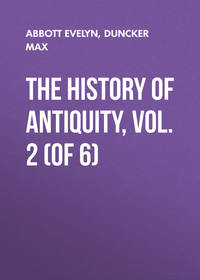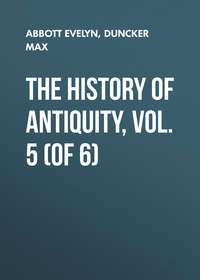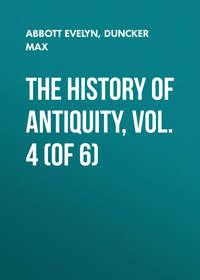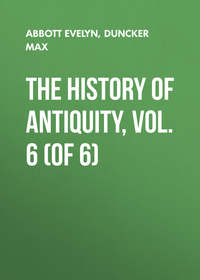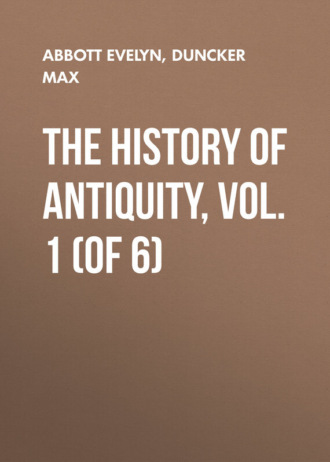 полная версия
полная версияThe History of Antiquity, Vol. 1 (of 6)
238
Rosell. "Monum. Stor." 1, 123, 136.
239
Champollion, "Lettres," p. 263-283; Brugsch, "Hist. d'Egypte," pp. 163-165.
240
Diod. 1, 47-49.
241
Brugsch, "Hist. d'Egypte," p. 151.
242
Lepsius, "Briefe," s. 112-115, 263, 403, 414.
243
As this statue bears on the right shoulder the shield Ra Apepi, or Apepa, it has been thought to be the statue of the shepherd king Apepi (p. 130). Lepsius regards it as a statue of Ramses II. – "Königsbuch," s. 44.
244
Brugsch, Hist. d'Egypte, pp. 197, 198.
245
Strabo, p. 816, puts the number of the royal sepulchres at forty. Diodorus, on the authority of the sacred records, speaks of forty-seven graves. At the time of Ptolemy I. only seventeen were in existence (Diod. 1, 46), and of these, at the time when Diodorus travelled in Egypt, the greater part were destroyed. Lepsius gives twenty-five graves of kings, and fifteen graves of the wives of the kings ("Briefe," s. 270).
246
Brugsch, "Reiseberichte," s. 324.
247
Lepsius, "Briefe," s. 288.
248
Brugsch, "Hist. d'Egypte," p. 128.
249
Lepsius, "Briefe," s. 266; Rosellini, "Mon. Stor." 3, 2, 284.
250
Bunsen, "Ægypten," 4, 213.
251
On the sketch of this tomb on a Turin papyrus, cf. Lepsius, "Abh. der Berl. Akad." 1867.
252
Diod. 1, 90.
253
Thus, e. g. in the Rosetta inscription the order is given that in every temple an image is to be set up to the "god Epiphanes, the avenger of Egypt," to whom the principal deity of the temple presents the arms of victory. Three times in every day the image of Epiphanes is to be worshipped, and on the great festivals the same honours are to be paid to him as to the rest of the gods. In addition, a special festival is solemnized every year to the god Epiphanes, and a special order of priests established for him. This resolution of the collected priests was ordered to be engraved on hard stone and set up in all the temples of the first, second, and third class. The full title of Epiphanes is: "Son of Ptah, Beloved of Ammon and Ra, the Child of the Sun, the Eternal."
254
Diod. 1, 53; Plut. "De Isid." c. 6, 9; and below, p. 211 ff.
255
Wilkinson, "Manners and Customs," Suppl. Pl. 76; Champollion, "Lettres," p. 344 ff.
256
In the inscriptions of the graves and sarcophagi of the Berlin Museum; cf. Ebers, "Ægypten," s. 300.
257
What Synesius (Op. p. 94) tells us of the election of the kings is so astounding that it can hardly have been part of any plan of the priests; the whole history of Egypt contradicts an elective monarchy of such a kind. These supposed elections were said to have taken place on the Libyan mountains, near Thebes; the priests mentioned the names of the candidates for whom the votes were to be given. The votes of the prophets had the value of one hundred, those of the lower priests of twenty, of the servants of the temple of ten, and of the warrior class of one.
258
Kalasiris was the name given by the Egyptians to a linen coat, with fringe round the thighs (Herod. 2, 81). The name Hermotybian has been derived from ἡμιτύβιον, a kind of apron.
259
Herod. 2, 37.
260
Diod. 1, 73, 74.
261
Herod. 2, 37, 168.
262
Genesis xlvii. 22, 26.
263
Herod. 2, 109 supra, p. 143.
264
Genesis xlvii. 24, 26.
265
Herod. 2. 168.
266
Genesis xlvii. 26.
267
Even the land which the Pharaohs allotted to the temples with a tax of a fifth belonged to them in a certain sense. We have tolerably ancient records on papyrus, on which are given the incomes of the temples, with the names of the tax-payers, and the things given in taxation. When the Ptolemies ruled over Egypt the land which paid to the temples belonged actually to the temples as property, but as property revocable at will, and the kings on their side taxed the temples just as the Islamite princes are accustomed to tax their mosques. In the Rosetta inscription, under date March 27, 196 B.C., the prophets, upper priests, chamberlains, pastophors, and scribes, explain that the king (Ptolemy Epiphanes) had given an order that the incomes of the temples and the land-taxes paid to them yearly, and the portions reserved for the gods in the vineyards and other property, should continue to be paid. At the same time we see from the sequel of this inscription, as well as from other sources, that these incomes were not sufficient to keep the temples in good order, and the king was compelled to make additions. Yet, in any case, the Ptolemies by their state taxes withdrew from the temples a portion of their incomes. From every plot of corn-land (ἄρουρα) the temples were to pay to the king an artabe of corn, and from every plot of vineyard an amphora of wine. Besides this, they had to pay a money-tax and a certain amount of byssus cloth.
268
Clemens ("Strom." p. 757 ff. ed. Pott) expressly says that the prophet was the overseer of the temple; on the other hand, in the inscription of Rosetta, the high priests and prophets stand side by side.
269
Herod. 2, 37, 143; Diod. 1, 73.
270
Diod. 1, 80; Herod. 2, 37, 81; Diog. Laert. 8, 27; Porphyr. "De abst." 4, 7.
271
Diod. 1, 74, 92.
272
Lepsius, "Briefe." s. 309, 310; Brugsch, "Hist. d'Egypte," p. 259.
273
Herod. 2, 47; Aelian, "De Nat. An." 10, 16. As Herodotus tells us that the swineherds married in their own order only, it follows that the other orders married with each other. The attempt has often been made to explain the so-called divisions of the Egyptians into castes by the immigration of foreign tribes. This conception places in mechanical layers what is really an organic development. In India such an assumption has a certain historical foundation. There, there was a servile class (the Sudra) under three superior classes; the first was composed of the original inhabitants, the others of the Aryan immigrants. This kind of division is wholly wanting in Egypt, and not less so any historical or physiological foundation for the immigrations. Strabo knows three orders only in Egypt; the priests, the soldiers, and the population engaged in work or trades. Diodorus (1, 74) speaks of five orders; i. e. in addition to the first two, husbandmen, artizans, and shepherds. Plato ("Timæus," p. 21) mentions priests, soldiers, artizans, shepherds, and hunters; Herodotus mentions priests, warriors, cowherds, swineherds, merchants, interpreters, and mariners. In Plato and Diodorus we miss the merchants, who certainly were not wanting in Egypt, and in Herodotus the husbandmen and artizans. Nothing therefore remains but the natural assumption that the labouring masses were chiefly divided into shepherds, artizans, and husbandmen; and these were again broken into many divisions according to their different vocations, and each of our authorities has brought into prominence those distinctions which especially came under his notice. As Herodotus especially notices cowherds, we must suppose that those herdsmen are probably meant who derived a living from the buffalo herds, which they pastured in the swampy flats of the Delta, on the border of Egypt, and lived in huts of reeds. – Diod. 1, 43.
274
The number of provinces in Egypt under the old kingdom appears to have been twenty-seven, according to the myth of the hewing of the body of Osiris into twenty-seven pieces, and the distribution of them to all the priests of the land for burial, which Diodorus has preserved. From this may be derived the number of twenty-seven courts in the labyrinth given by Strabo, p. 811, and twenty-five in Pliny, pp. 113, 114; as a fact the building had only twelve courts. Yet Strabo mentions thirty-six provinces (p. 787). Later coins give forty-six provinces, and Ptolemy forty-seven. Forty-four nomes, twenty-two for Upper Egypt and as many for Lower Egypt, can be established, together with their names. – Brugsch, "Hist. d'Egypte," p. 9.
275
Diod. 1, 73, 75, 94; Herod. 2, 136; Plut. "De Isid." 10; Chabas, "Mél." 3, 10.
276
Diod. 1, 77 ff.
277
Herod. 2, 37, 38, 39, 65; Genesis xliii. 32.
278
Herod. 2, 77, 85; Diod. 1, 84, 91.
279
Lepsius, "Aelteste Texte," s. 10; Brugsch, "Grammaire démotique."
280
Clem. Alex. "Strom." p. 758, ed. Pott; cf. Diod. 1, 49.
281
Ebers, "Augsburger Allg. Zt." 1873. On a papyrus of a medicinal character of the period from the twentieth to the twenty-second dynasty, see Birch, "Zeitschrift für ægyptische Sprache," 1871, s. 61.
282
Herod. 2, 84, 3, 1.
283
Lepsius, "Götterkreis," s. 30; Bunsen, "Ægypten," 5, 1, 189 ff.
284
Papyrus, Sallier III.
285
De Rougé, "Recueil de Travaux," 1, 3 ff.; Chabas, "Revue Archéol." 1875.
286
On the papyrus Sallier I.; "Revue Archéol." 1860, 2, 241.
287
Goodwin-Chabas, loc. cit. 1861, 4, 118 ff.
288
Loc. cit. 1860, 1, 357.
289
De Rougé, loc. cit. 1852. On another very marvellous narrative on a papyrus in the demotic character, see Brugsch, loc. cit. 1867, 16, 161 ff. This papyrus Brugsch, on paleographical grounds, places in the third or second centuries B.C.
290
Lauth, "Sitzungsberichte der Akademie, zu München," 1872, 347 ff, and his "Abhandlung über den papyrus Sallier II. und Anastasi III.;" ibid. p. 29 ff.; cf. Chabas, "Voyage d'un Egyptien," and Goodwin, "Saneha."
291
Bœckh, "Manetho und die Hundsternperiode;" Lepsius, "Chronologie," s. 470 ff. and supra, p. 40.
292
Diod. 1. 81.
293
Brugsch, "Zeitschrift d. d. M. S." 10, 662 ff.
294
The Egyptians then compared certain constellations in their spheres with the signs of the zodiac. The Crab they denoted by the scarabæus, the Lion by the knife, the Scales became the "sun-mountain," the Scorpion became the snake. The Kid was with them "the life," the Ram "the slain" &c. – Brugsch, loc. cit.
295
Champollion, "Lettres," p. 239; Lepsius, "Chronologie," s. 109, 110; cf. supra, p. 58.
296
Champollion, "Lettres," p. 196.
297
Diod. 1, 74.
298
Wilkinson, "Manners and Customs," 3, 4.
299
Strabo, p. 758; cf. p. 147.
300
Supra, p. 94; Ebers, "Durch Gosen," s. 135 ff.
301
Herod. 2, 78.
302
Wilkinson, "Manners and Customs," 2, 132.
303
Cf. infra, Book II. cap. 3.
304
1 Kings x. 28, 29; 2 Chronicles i. 16, 17; ix. 28.
305
"Od." 14, 288; 4, 225, 355; 17, 448; Movers, "Phœnizier," 2, 70.
306
Xenoph. "Cyrop." 7, 5; Strabo, pp. 41, 84, 544, 736, 737.
307
Strabo, p. 748; Xenoph. "Anab." 1, 5, 1 ff.; G. Hertzberg, "Feldzug der Zehntausend," s. 139 ff.
308
Beros. ap. Sync. p. 28; Herod. 1, 193; "Anab." 2, 3.
309
Herod. 1, 178-200.
310
"De Cœlo," p. 503.
311
Diod. 3, 31; Cic. "De Divin." 1, 19; Jul. Afric. ap. Syncell. p. 17; Plin. "Hist. Nat." 7, 57; cf. H. Martin, "Revue Archéol." 1862, 5, 243.
312
Between 280-270 B.C. Clinton, "Fasti Hell." ad ann. 279.
313
Abydeni Fragm. 9, ed. Müller.
314
Berosi Fragm. 1, ed. Müller.
315
Abyd. Fragm. 1, 2, ed. Müller; Berosi Fragm. 5.
316
In the Armenian Eusebius, p. 10, ed. Schœne, the name is Lancharis.
317
G. Smith, "Bibl. Arch." 3, 531.
318
So in the Armenian Eusebius; in Syncellus it is five stadia, i. e. 3,000 feet long.
319
Eusebius, p. 14, ed. Mai; Syncell. p. 30; Abydeni Fragm. 3 ed. Müller; Lucian, "De Dea Syria," 12.
320
Eusebius gives 33,091. As Syncellus enumerates the sares, neres, and sosses, the number given in the text is the correct one, or must be replaced by 34,091. The basis of the calculation which Syncellus has adopted in the four first dynasties of Berosus has been thoroughly established by Lepsius ("Chronol. der Ægypter," s. 78).
321
The period of the fourth dynasty, the eleven kings, is filled up to 248 years from the marginal note on the Armenian manuscripts of Eusebius.
322
G. Smith, "Assyrian Discoveries," p. 185-195. I retain the reading "Sisit" as against Hasisadra because of the "Sisythes" of Lucian.
323
According to Bunsen, "Ægypt." 5, 2, 61 ff., the Hebrews originally were acquainted with only seven patriarchs before the flood; see below.
324
Gen. ix. 20, 28; xi. 2-9.
325
Plin. "Hist. Nat." 6, 30. Hipparenum can be nothing but Sipparenum, or Sipparenorum.
326
If the number 34,091 be correct (p. 241, note 2), the year 2447 B.C. would be the first year of the historical era.
327
It is pointed out by Von Gutschmid in the Rhein. Mus. 8, 252.
328
Gen. x. 22; x. 8, 10.
329
Menke, "Jahrb. für classiche Philologie," 1862, s. 545.
330
Aesch. "Pers." 16.
331
The name Nanchundi occurs also in the compounds Istar-Nanchundi, p. 253.
332
G. Smith, "Assurbanipal," p. 200, 234-236, 249-251. As in two passages 1,635 years are given with quotation of the Neres and Sosses, this number must be kept in the third passage instead of 1,535 years. The conquest of Susa did not follow immediately on the conquest of Babylon, in the year 647; see below.
333
Sayce, "Bibl. Arch." 3, 479; Oppert, "Empires de Chaldée et d'Assyrie," p. 27.
334
G. Smith, "Discov." p. 234; "Early Hist." p. 58.
335
Genesis, xiv. 1-12; G. Smith, "Assurb." p. 228.
336
Also in Ménant, "Les Achémenides," p. 136.
337
G. Smith, "Assurbanipal," p. 224, ff.
338
Sayce, "Transact. Bibl. Arch." 3, 465, 485.
339
So Rawlinson, Norris, Mordtmann, "Zeitschrift d. d. M. G." 1870, s. 7, 76, and Sayce, loc. cit.
340
Norris, "Dict." I. 50.
341
Such is also the opinion of Eberhard Schrader.
342
Schrader, "Abstammung und Ursitze der Chaldæer," s. 405 ff., 416 ff.
343
Strabo, p. 735, 765, 767; Pliny, "Hist. Nat." 6, 23, 27. 5, 20.
344
On the correct interpretation of the passage, Isaiah xxiii. 13, see Schrader, "Keilschriften und Alt. Test." s. 269; on the Armenian Chaldæans, the Chalybian Chaldæans, Schrader, "Abstammung der Chaldæer," s. 399, 400. The former are to be sought for in the valley of the Lycus, and are known to the Armenians as Chalti: Kiepert, "Monats-Berichte der B. Akad. d. W." 1869. Arphaxad, i. e. the high mountain district Albak (Kiepert, loc. cit. s. 200), on the Upper Zab, was on the other hand undoubtedly colonised by Semitic tribes; but these probably came from Mesopotamia and Assyria. Arphaxad is the younger brother of Elam and Asshur. Where to look for Kir, whence, according to Amos ix. 7; i. 5, the Syrians came, we do not know.
345
Schrader, "Assyrisch-babyl. Keilschriften," s. 382, 18, 42, 165, 225.
346
Schrader, "Keilschriften und Alt. Test." s. 383.
347
Oppert, "Inscript. des Sargonides," p. 55 ff.
348
Above, pp. 132, 151, 152. From Naharina Tuthmosis III. received, among other things, forty-seven tiles of lead, forty-five pounds of gold, eighty-one mana (minæ) of spice. – De Rougé, "Notice," pp. 16, 18.
349
Oppert, "Empires," pp. 16, 17; G. Rawlinson, "Five Monarchies," 1, 63, 64, 137; Ménant, "Babylone," pp. 74, 75, 254.
350
G. Smith, "Early History," p. 36; G. Rawlinson, "Five Monarchies," pp. 69, 94, 157 ff.
351
Oppert, "Empires," p. 21.
352
Schrader, "Keilsch. und Alt. Test." s. 47; "Assyrisch-babylonische Keilschriften," s. 162; Sayce, "Zeitschrift für ægypt. Sprache," 1870, s. 151; Ménant, "Babylone," p. 98.
353
Oppert, "Empires," p. 36.
354
Lenormant, "Lettres Assyr." 1, 249.
355
Oppert, "Empires," p. 28; Ménant, "Babylone," pp. 118, 121.
356
G. Rawlinson, "Five Monarchies," pp. 169, 170.
357
G. Smith, "Discov." p. 236 ff., gives a deed of gift of Merodach-Baladan, the son of Milihiru, the grandson of Kurigalzu.
358
Ménant, "Babylone," pp. 127, 128.
359
Diod. 2, 30.
360
Nicol. Damasc. Fragm. 9, 10, ed. Müller.
361
Pindari Fragm. adesp. 83, ed. Bergk.
362
Schrader, "Assyr. – babyl. Keilschriften," s. 123; "Keilschriften und Alt. Test." s. 280.
363
G. Rawlinson, "Five Monarchies," p. 130.
364
2 Kings xvii. 31.
365
Amos v. 26.
366
Eberhard Schrader, "Theologg. Studien und Kritiken," 1874, 2, 324 ff.
367
Schrader, "Keilschriften und Alt. Test." s. 167, 272; "Assyr. – babyl. Keilschriften," s. 88, 129, 140.
368
Ménant, "Babylone," pp. 201-203.
369
Munter, "Religion der Babylonier," s. 28.
370
Herod. 1, 199.
371
Baruch, vi. 42, 43 (Ep. Jerem.); cf. Genesis xxxviii. 14 ff.
372
Ménant, "Babylone," p. 204.
373
Schrader, "Abstammung der Chaldæer," s. 405. So, too, Istar of Agane is opposed to Istar of Erech.
374
G. Smith, "Discov." p. 220; Schrader, "Höllenfahrt," p. 15 ff.
375
Schrader, "Keilschriften und Alt. Test." s. 69, 85, 86.
376
G. Smith, "Assurbanipal," p. 201.
377
Diod. 2, 30.
378
Plutarch, "De Isid." c. 48.
379
Diod. 2, 30.
380
Diod. 2, 31.
381
Sayce, "Bibl. Arch." 3, p. 137.
382
2 Kings xxiii. 5-7.
383
Diod. 2, 31.
384
Stuhr, "Die Religionsysteme der Völker des Orients," 1, 424.
385
Sayce, "Bibl. Archæol." 3, p. 153.
386
Diod. 2, 30, 31; Daniel 4, 4.
387
Above, p. 268; Strabo, p. 739.
388
Movers, "Religion der Phœnizier," 2, 262, 275.
389
Schrader, "Assyrisch. Babyl. Keilschriften," s. 105.
390
G. Smith, "Discov." pp. 387, 388; Ménant, "Les Achæmenides." Recently a tablet has been found, supposed to belong to the time of Cæsar.
391
De Rougé, "Sur l'Origine Egyptienne de l'Alphabet Phénicien;" Lauth, "Sitzungsber. d. Bair. Akad. d." 10, 1867, pp. 84-124. The inscription of Mesha, king of Moab, proves by the formation and use of the letters that this alphabet had been known for a long time.
392
The Basalt duck of Irba Marduk – no doubt a piece of Babylonian booty – was found at Nineveh. – Layard, "Discoveries," p. 601; Schrader, "Assyr. Babyl. Keilschrift," s. 175; De Vogué, "Rev. Arch." 11, 366.
393
Ideler, "Handbuch der Chronologie," 1, 207; Sayce, "Bibl. Arch." 3, p. 160.
394
Ideler, "Sternkunde der Chaldaer," s. 214.
395
Brandis, "Münzwesen," s. 20 ff.
396
Herod. 2, 109.
397
Brandis, "Münzwesen Vorderasiens," s. 36 ff.
398
George Smith, "Records of the Past." 3, 11.
399
These statements are founded on the more recent forms established by Brandis, "Münzwesen Vorderasiens," s. 158, ff.
400
Brandis, loc. cit. s. 85.
401
H. Rawlinson, "Journ. Asiat. Soc." 1861, 18, 2 ff.
402
The assumption that the Birs Nimrud is the temple Beth-Sida at Borsippa is contradicted by the inscriptions. The measurements of the temple give no support for such a theory, even if the forty-two cubits of the cylinders of Rawlinson are interpreted with Norris, "Dict." p. 280, by Amatgagar; for we do not know the value of this measure exactly. I cannot regard Borsippa as a part of Babylon in the teeth of the direct testimony of Strabo (p. 728), Justin (12, 13), and Ptolemy (5, 20). The inscriptions of the Assyrians, and, not least, those of Nebuchadnezzar himself, always mention Borsippa beside Babylon. If it be maintained that in spite of this Nebuchadnezzar might have included Borsippa in the walls of Babylon, the theory is contradicted by Berosus (Joseph, "c. Apion." 1, 20), according to whom Cyrus besieges and takes Babylon while Nabonetus is blocked up in Borsippa, and by Nebuchadnezzar himself, who, after speaking of the great walls of Babylon, adds: – "I also laid the foundations of the walls of Borsippa, the Tabi-subur-su" (Ménant, "Babylone," p. 205).


